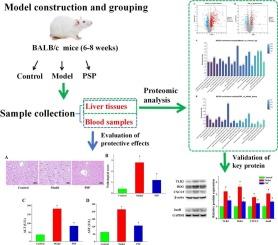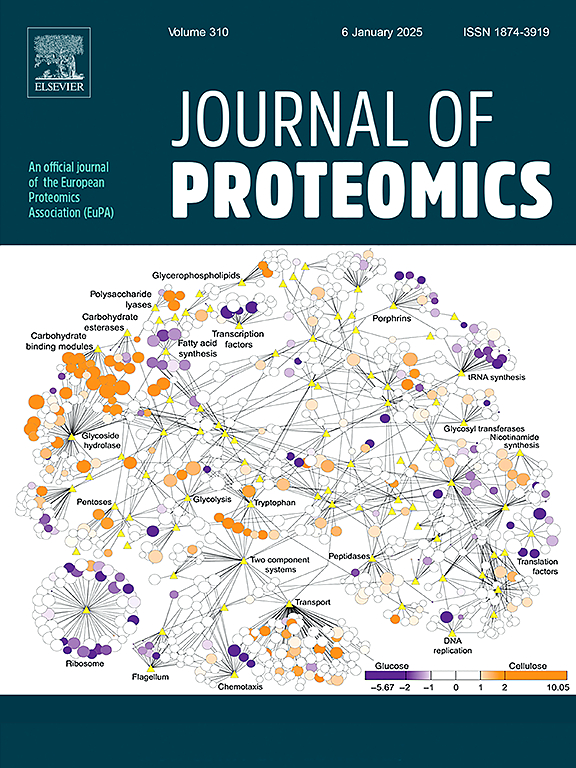TMT-based quantitative proteomics unveils the protective mechanism of Polygonatum sibiricum polysaccharides on septic acute liver injury
IF 2.8
2区 生物学
Q2 BIOCHEMICAL RESEARCH METHODS
引用次数: 0
Abstract
Polygonatum sibiricum polysaccharides (PSP) has been shown to possess multiple pharmacological functions. Our previous study found that PSP could protect against acute liver injury during sepsis via inhibiting inflammatory response. However, the underlying molecular mechanism by which PSP alleviates septic acute liver injury (SALI) remains unknown. Herein, TMT-based quantitative proteomics was utilized to explore the essential pathways and proteins involved in the protective effects of PSP on SALI. The results revealed that 632 and 176 differentially expressed proteins (DEPs) were identified in Model_vs_Control and PSP_vs_Model, respectively. GO annotation showed similar trends, suggesting that these DEPs were primarily involved in the cellular anatomical entity in Cellular Component, the cellular processe and the biological regulation in Biological Process, the binding and the catalytic activity in Molecular Function. Meanwhile, KEGG enrichment analysis implied that four common pathways, including the NF-κB signaling pathway, the IL-17 signaling pathway, the TNF signaling pathway and the Toll-like receptor signaling pathway, were closely associated with the pathogenesis of sepsis among the top 20 remarkably enriched pathways in Model_vs_Control_up and PSP_vs_Model_down. Moreover, the levels of several common DEPs, including TLR2, IKKi, JunB and CXCL9, were validated by WB, which was in line with the results of proteomics. Therefore, the protective effects of PSP on SALI might exert via blocking the above-mentioned inflammation pathways.
Significance: PSP, recognized as a key component of Polygonatum sibiricum, exhibits a range of pharmacological functions. Our previous study found that PSP could protect against SALI, yet failing to clarify the mechanism of action. To reveal the underlying molecular mechanism involved in the protective effects of PSP on SALI, a TMT-based quantitative proteomic analysis was performed to detect and analyse the DEPs in liver tissue among the control group, the model group and the PSP group in this study. The results provide theoretical references for exploring the action mechanism of drugs and facilitate the comprehensive utilization of PSP.
Significance
PSP have been identified as the most crucial components of Polygonatum sibiricum with various pharmacological functions. Our previous study found that PSP could protect against SALI, but the mechanism of action remains unknown. To reveal the underlying molecular mechanism involved in the protective effects of PSP on SALI, a TMT-based quantitative proteomic analysis was performed to detect and analyse the DEPs in liver tissue among the control group, the model group and the PSP group in this study. The results provide theoretical references for exploring the action mechanism of drugs and facilitate the comprehensive utilization of PSP.

基于TMT的定量蛋白质组学揭示何首乌多糖对脓毒性急性肝损伤的保护机制
何首乌多糖(PSP)已被证明具有多种药理作用。我们之前的研究发现,何首乌多糖可通过抑制炎症反应来防止脓毒症急性肝损伤。然而,PSP减轻脓毒症急性肝损伤(SALI)的潜在分子机制仍然未知。在此,研究人员利用基于TMT的定量蛋白质组学探讨了PSP对脓毒性急性肝损伤的保护作用所涉及的重要通路和蛋白质。结果表明,在模型与对照和 PSP 与模型中分别发现了 632 和 176 个差异表达蛋白(DEPs)。GO注释显示出相似的趋势,表明这些差异表达蛋白主要参与细胞成分(Cellular Component)中的细胞解剖实体、生物过程(Biological Process)中的细胞过程和生物调控、分子功能(Molecular Function)中的结合和催化活性。同时,KEGG富集分析表明,在Model_vs_Control_up和PSP_vs_Model_down的前20条显著富集通路中,NF-κB信号通路、IL-17信号通路、TNF信号通路和Toll样受体信号通路等4条常见通路与败血症的发病机制密切相关。此外,TLR2、IKKi、JunB和CXCL9等几种常见DEPs的水平也得到了WB验证,这与蛋白质组学的结果一致。因此,PSP 对 SALI 的保护作用可能是通过阻断上述炎症通路实现的。意义:PSP 是何首乌的主要成分,具有多种药理作用。我们之前的研究发现,PSP 可预防 SALI,但未能阐明其作用机制。为了揭示PSP对SALI的保护作用所涉及的分子机制,本研究采用基于TMT的定量蛋白质组学分析方法,检测和分析对照组、模型组和PSP组肝脏组织中的DEPs。研究结果为探索药物的作用机制提供了理论参考,有助于PSP的综合利用。意义:PSP 是何首乌中最重要的成分,具有多种药理作用。我们之前的研究发现,PSP 可预防 SALI,但其作用机制尚不清楚。为揭示PSP对SALI的保护作用所涉及的分子机制,本研究采用基于TMT的定量蛋白质组学分析方法,检测和分析对照组、模型组和PSP组肝脏组织中的DEPs。研究结果为探索药物的作用机制提供了理论参考,有利于PSP的综合利用。
本文章由计算机程序翻译,如有差异,请以英文原文为准。
求助全文
约1分钟内获得全文
求助全文
来源期刊

Journal of proteomics
生物-生化研究方法
CiteScore
7.10
自引率
3.00%
发文量
227
审稿时长
73 days
期刊介绍:
Journal of Proteomics is aimed at protein scientists and analytical chemists in the field of proteomics, biomarker discovery, protein analytics, plant proteomics, microbial and animal proteomics, human studies, tissue imaging by mass spectrometry, non-conventional and non-model organism proteomics, and protein bioinformatics. The journal welcomes papers in new and upcoming areas such as metabolomics, genomics, systems biology, toxicogenomics, pharmacoproteomics.
Journal of Proteomics unifies both fundamental scientists and clinicians, and includes translational research. Suggestions for reviews, webinars and thematic issues are welcome.
 求助内容:
求助内容: 应助结果提醒方式:
应助结果提醒方式:


